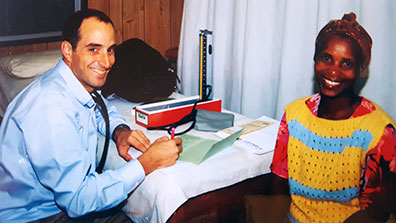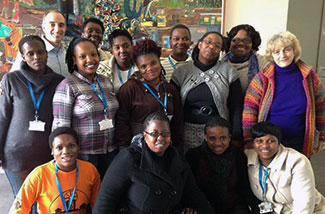Cardiologist Dr Thomas Gaziano examines cost-effective strategies
July / August 2017 | Volume 16, Issue 4

Photo courtesy Dr. Thomas Gaziano
Dr. Thomas Gaziano used his Fogarty IRSDA grant for early-
career scientists to develop a simple screening tool for
cardiovascular disease in South Africa.
As a cardiologist and researcher, Dr. Thomas Gaziano identifies cost-effective ways to prevent, diagnose and treat cardiovascular disease (CVD), the leading cause of death in the U.S. and worldwide. Much of the research he conducts today, he says, stems from his Fogarty grant for early-career scientists.
From 2004-2012, Gaziano held an International Research Scientist Development Award (IRSDA), which enabled him to work in South Africa and India. He says the experience introduced him to collaborators, allowed him to generate an ongoing line of research, and led to more funding aimed at reducing the burden of CVD in developing and developed countries.
"The grant's requirement to conduct your research and spend time in other countries outside the U.S. is absolutely critical. And, for me it was life changing," says Gaziano, who has degrees in medicine and health policy. In addition to his position as an assistant professor at Harvard's Medical School and School of Public Health, he is a physician at the Harvard-affiliated Brigham and Women's Hospital in Boston, Massachusetts.
During his IRSDA years, Gaziano devised and demonstrated the effectiveness of a low-cost screening tool for CVD that could be used in areas with limited resources, working under the mentorship of Professors Lionel Opie in South Africa and Srinath Reddy in India. The risk assessment is based solely on information easily obtained in a clinic or home visit - such as body-mass index, blood pressure, and health history - and was shown to be as sensitive as a laboratory-based assessment that requires blood tests for cholesterol.
After developing and validating the risk score, Gaziano began to address other related questions. Because he volunteered regularly in clinics in India and Africa, Gaziano knew the facilities were often short-staffed and overcrowded with patients, some of whom could spend up to a day walking to a provider. So, he and colleagues investigated whether community health workers could be trained to use the simple CVD screening tool to identify people at high risk and then refer them to a health center. His research showed it was a cost-effective approach in the three countries where it was evaluated - South Africa, Mexico and Guatemala.
That prompted another question: if people are identified as high risk and referred to a health center, will they go? More recently, he and his team developed a mobile phone app that is both a CVD risk calculator and electronic appointment scheduling system and are now testing it Argentina.

Photo courtesy Dr. Thomas Gaziano
Dr. Thomas Gaziano (back row, far left) stands with
community health workers in South Africa, who were trained
to use the non-laboratory-based cardiovascular disease
screening tool he developed with his Fogarty IRSDA grant.
He conducts this and other research with colleagues he met during his IRSDA and with grants that followed from NIH's National Heart, Lung and Blood Institute (NHLBI), Fogarty and other funders. He and colleagues at the University of Cape Town were awarded an NHLBI Center of Excellence award to address prevention and treatment of chronic diseases in South Africa, and he was the principal investigator working with his U.S. mentor on an NIH R01 grant to examine the cost-effectiveness of CVD screening strategies in the U.S. and South Africa. Along with a colleague in India, Dr. Prabhakaran Dorairaj, Gaziano edits the cardiovascular volume of the Disease Control Priorities Project, which aims to reduce the global burden of disease.
The IRSDA stipulation that grantees live and work outside the U.S. provides exposure to problems another country faces that may be different from the U.S., even for the same disease, and creates the opportunity for lasting relationships, Gaziano notes. "It's one thing to call, write, or email someone in another country and ask them to collaborate with you," he explains. "It's a very different experience once you've developed trust and a relationship. They believe you are interested in their country's problems, and understand them, because you've spent time there."
Gaziano says his IRSDA experience cemented his interest in global health. "As a result of that Fogarty grant, rather than just being a hobby, it's a major part of my research portfolio."
More Information
To view Adobe PDF files,
download current, free accessible plug-ins from Adobe's website.